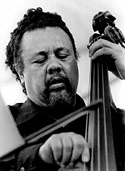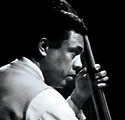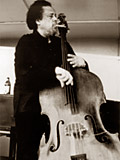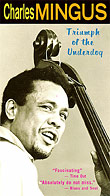|
Born April 22, 1922 in Nogales, AZ
Died January 5, 1979 in Cuernavaca, MX
Charles Mingus was one of the most important African American figures in jazz and any other music. Mingus was a double bassist, sometimes pianist, bandleader, and one of the most brilliant composers who ever lived. One song he composed was called "Fables of Faubus" which was originally released on the LP "The Original Faubus Fables" and then reissued on his most popular album "Mingus Ah Um". The "Faubus Fables" was a song about former Arkansas governor Orval E. Faubus. Faubus called the National Guard over to Arkansas because he was trying to hinder the integration of schooling in Little Rock.
Mingus had some other serious compositions such as "Goodbye Pork Pie Hat", which was this time written about legendary tenor saxophonist Lester Young. Young died two months before the recording of the Columbia LP "Mingus Ah Um". Young killed himself with a serious overdose of alcohol and marijuana. Young, who was very influential to Mingus and other jazz artists, was only 49 years old when he died.
"Goodbye Pork Pie Hat" is a slow minor ballad dedicated to "Pres" (Lester Young). Out of these two minor tunes, Mingus had yet another popular tune released on "Mingus Ah Um". This time it was fast, major, and had background gospel shouts. It was called "Better Git It In Your Soul". It is influenced by the preaching Mingus heard at churches as a child. The tune features background clapping and singing, mostly during solos. It is opened with a very brief soli introduction of the brilliant playing of Charles Mingus, a play-along piano by Horace Parlan, and moaning sounds from the trombone of Jimmy Knepper. After this solo, it goes into a fast gospel sounding melody. It was later reissued on his most popular 'live' album "Mingus at Antibes", but as "Better Git Hit In Yo Soull".
These three songs, "Fables of Faubus", "Goodbye Pork Pie Hat", and "Better Git It In Your Soul", were all featured on one album, the Columbia Records LP "Mingus Ah Um" which was originally released in 1959, the most important year of jazz. This album shows the true talent of Mingus, whether he's playing simple walking time, slap stick, or fast solos. Along these three tunesfeatured are more of Mingus's compositions. "Boogie Stop Shuffle", "Self Portrait in Three Colors", and "Jelly Roll" are included to showcase his composing talent. Before this astonishing LP, Mingus was just an underrated sideman. He was featured in the Charlie Parker quartet in the bebop days. You can also find him as a sideman on early 1950's recordings, such as "The Eminent Vol. 2" by JJ Johnson.
Sadly after many other famous record lables of his, such as "The Clown", "Blues and Roots", The Black Saint and the Sinner Lady", "Mingus Dynasty" and "Oh Yeah", Mingus died in 1979. He was suffering mental problems, drug overdose, back problems, which kept him in a wheel chair for years. In his remaining years before his death, he wrote songs for big bands. Now there is a band in memory of Charles Mingus called The Mingus Big Band. They play Mingus' songs at very popular jazz festivals and concerts. Ever since his death, people like the members of the Mingus Big Band, and other fans, have always and will always remember the life and the brilliant talent of Charles Mingus.
|




|
|
Greatest Jazz Artists - #9
Greatest Jazz Bassists - #1
Greatest Jazz Instrumentals - #5, #27, #99
Greatest Jazz Ballads - #4, #5, #54, #90
Greatest Jazz Albums - #3, #48, #59, #127
|
